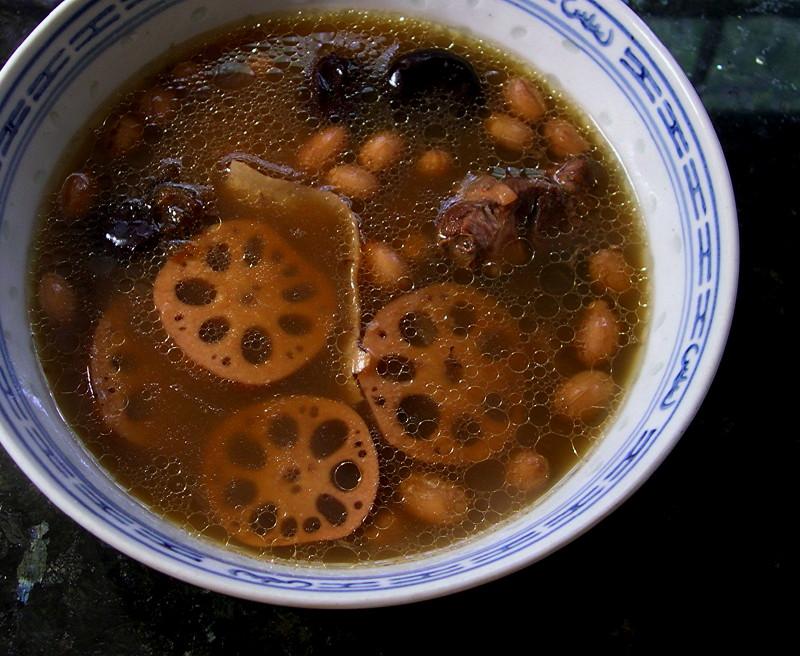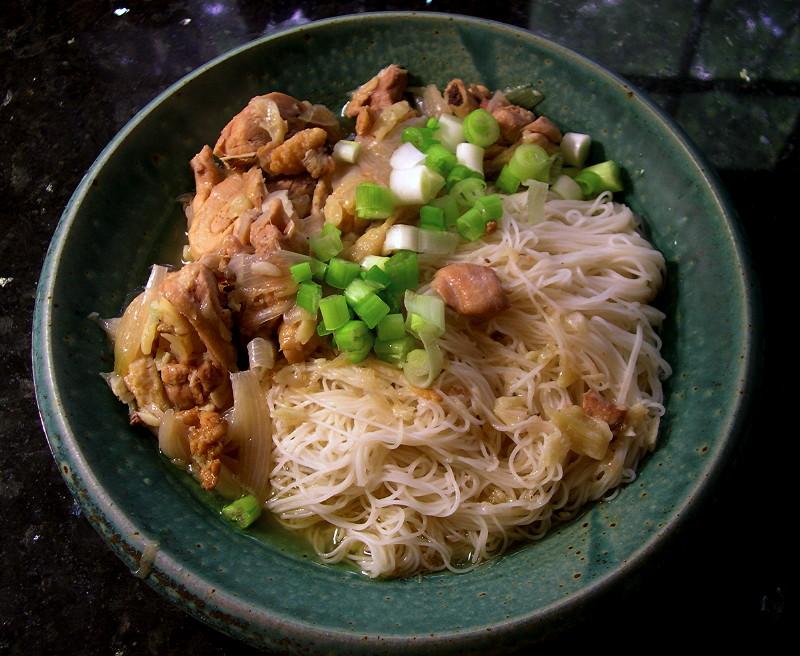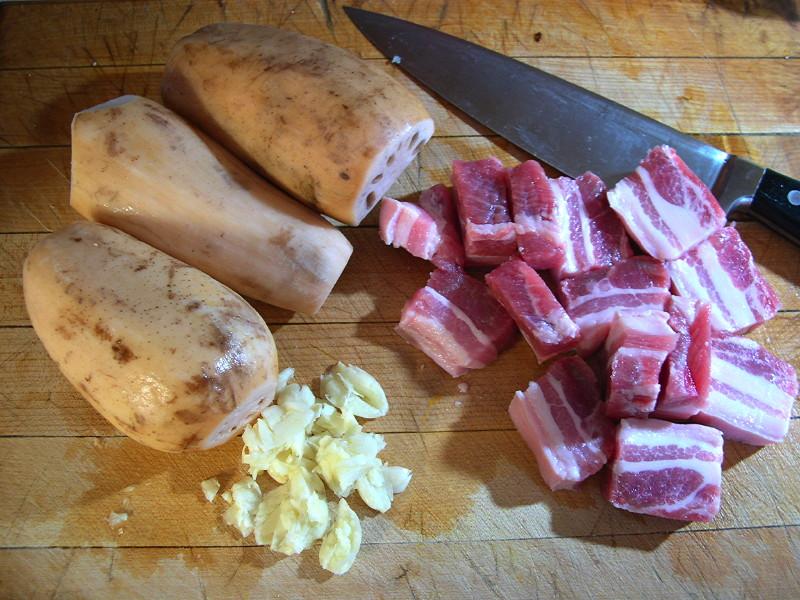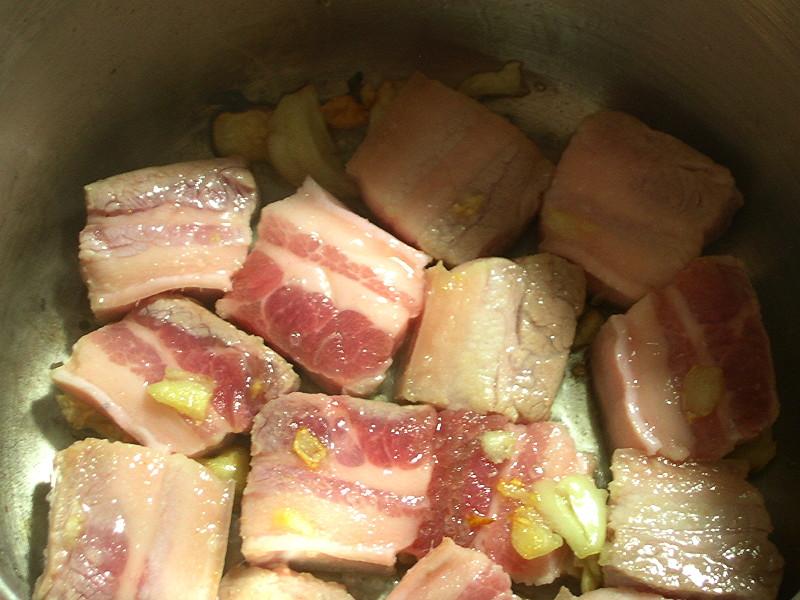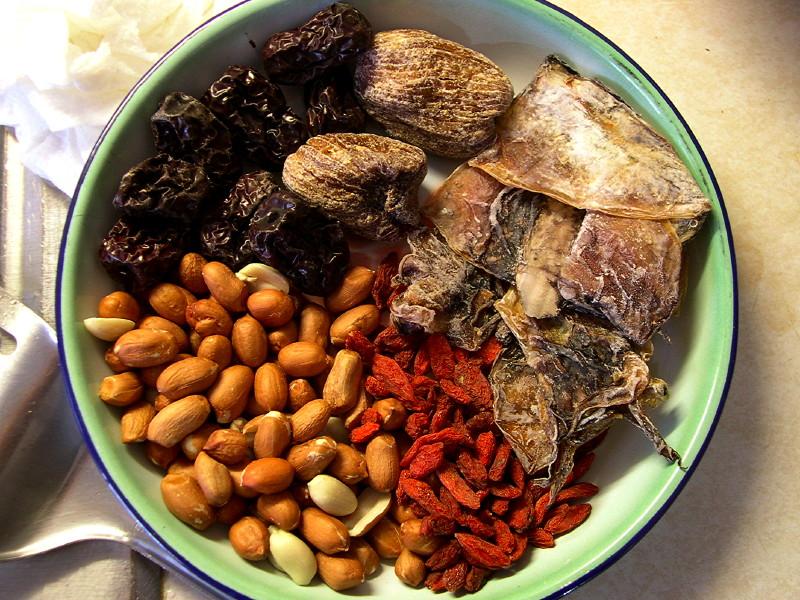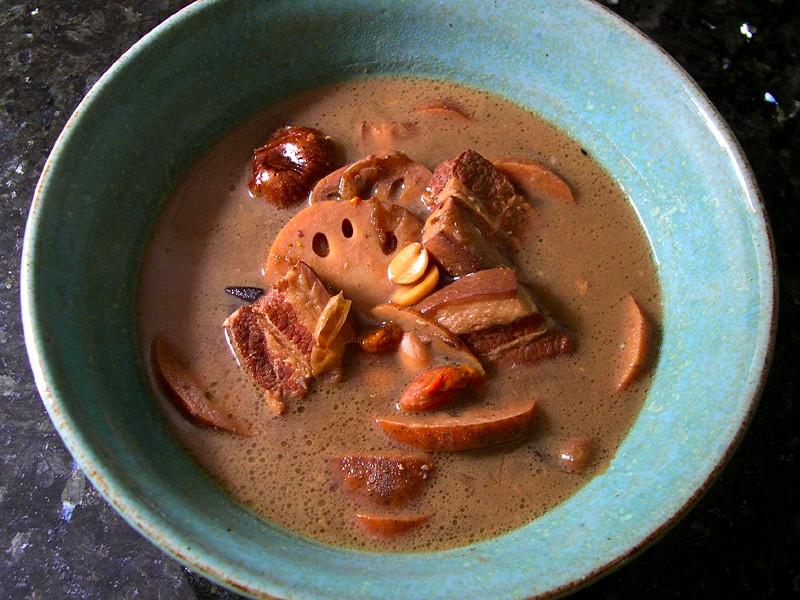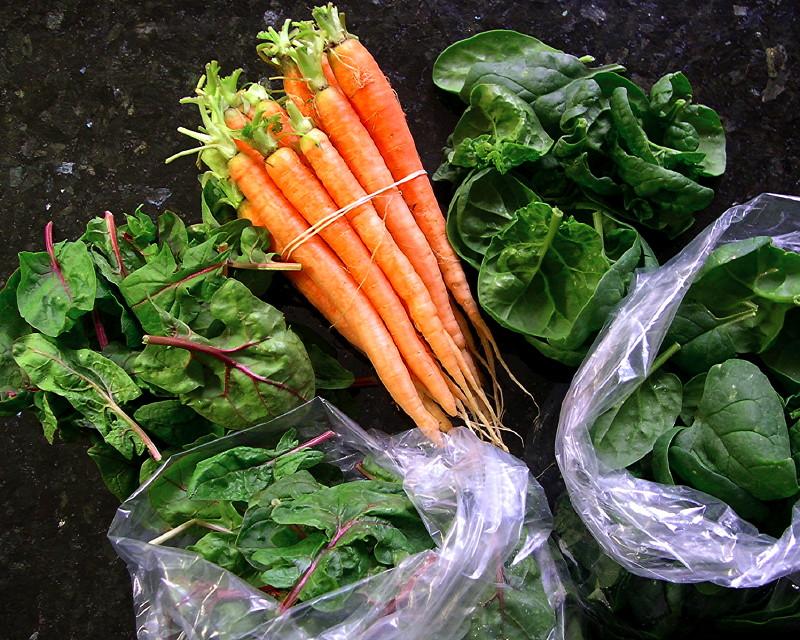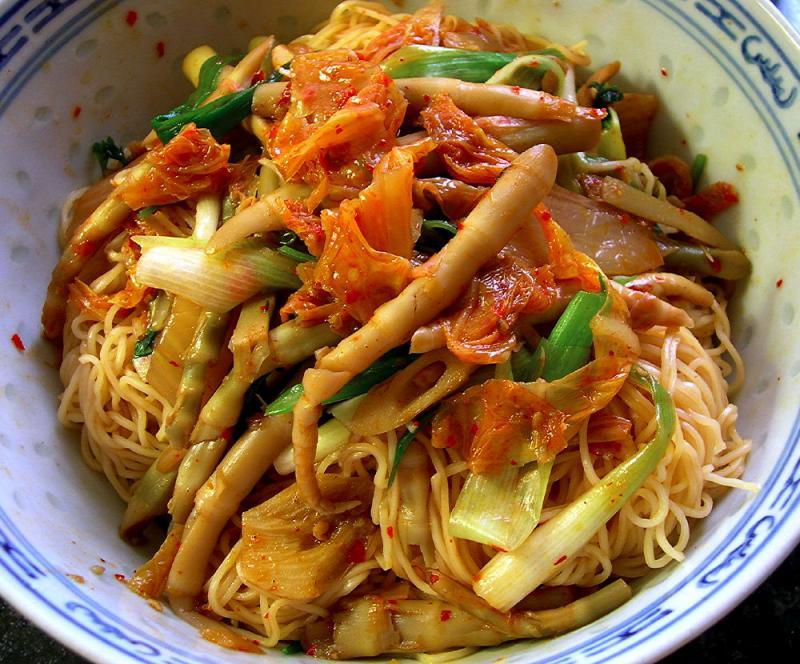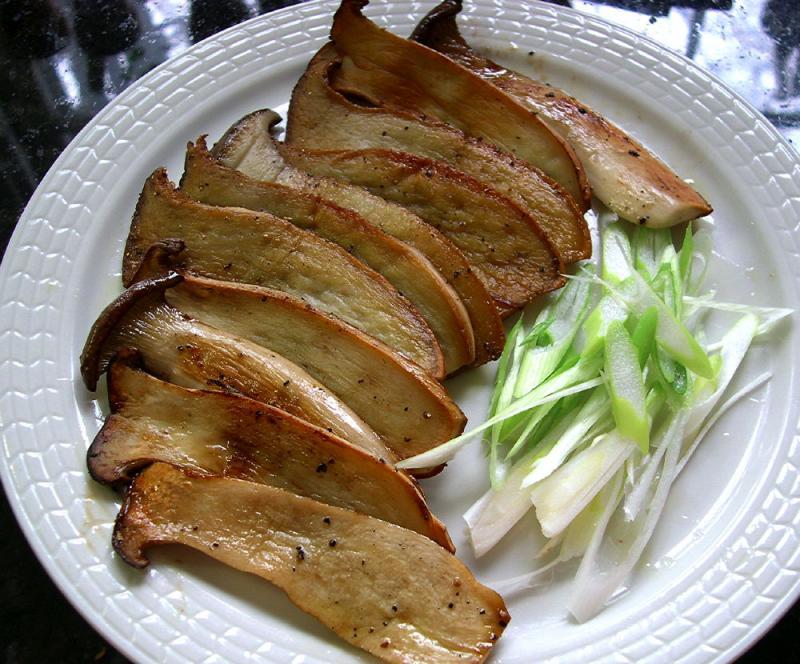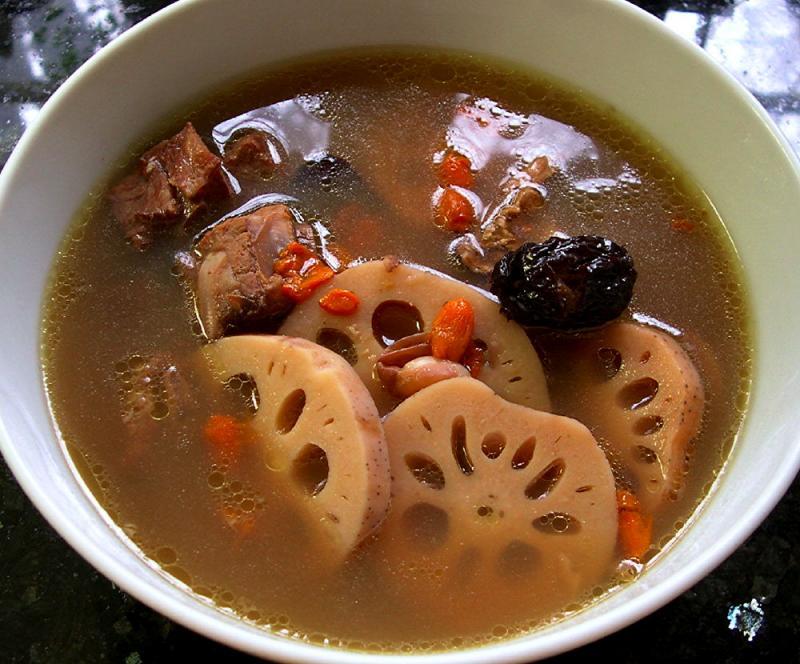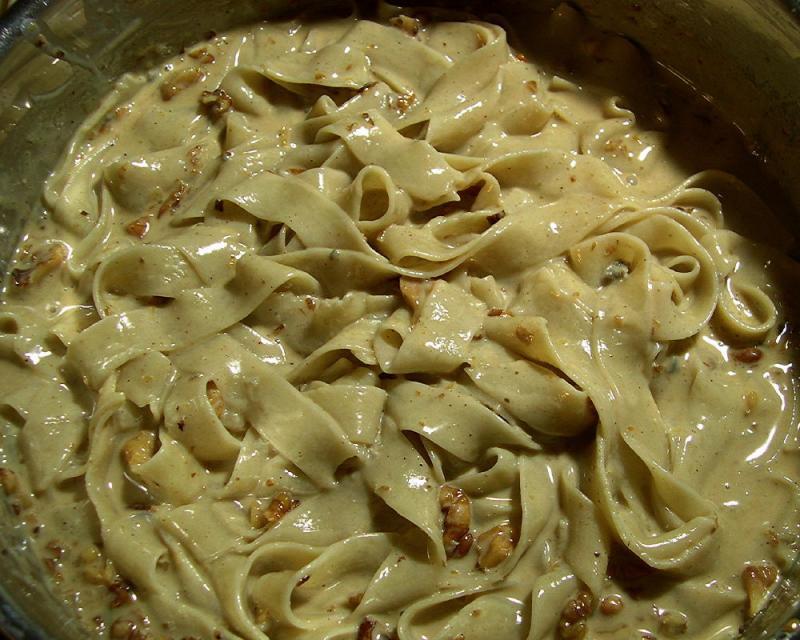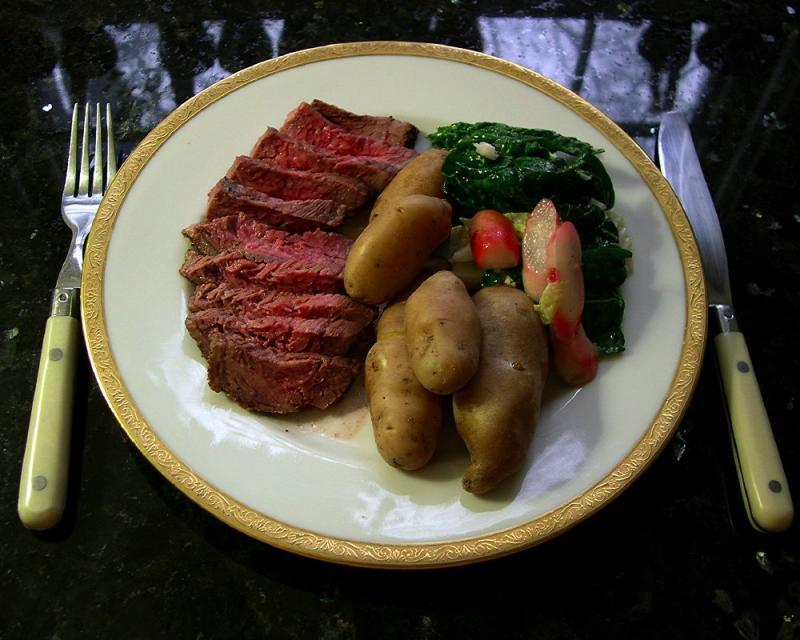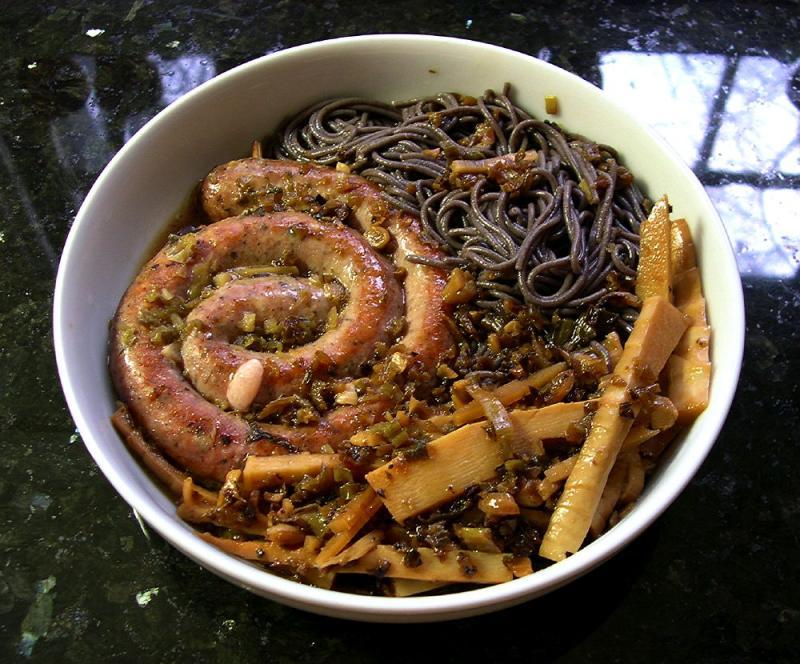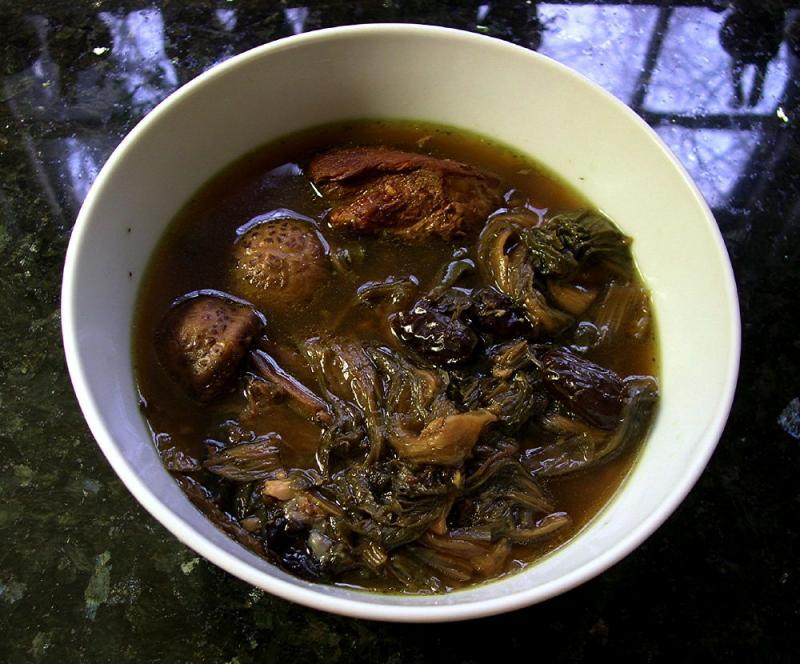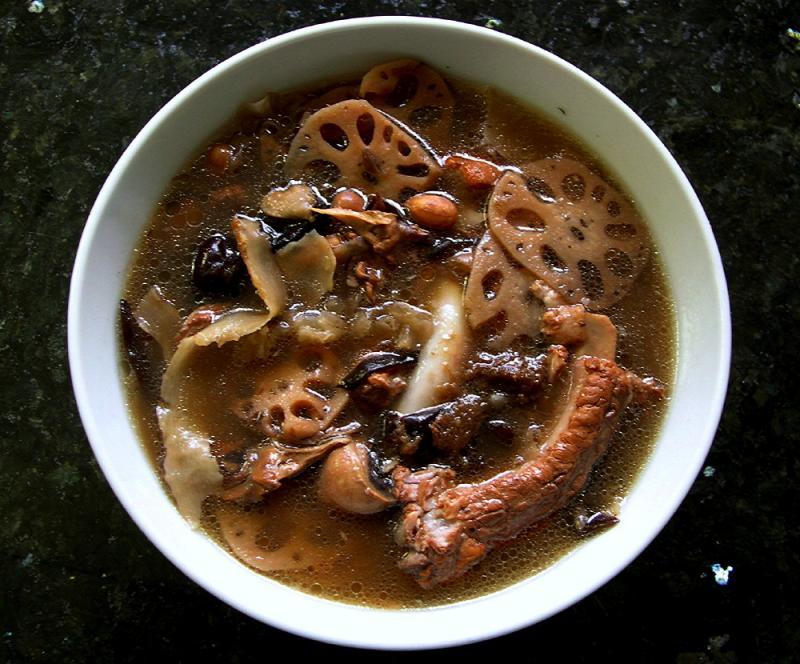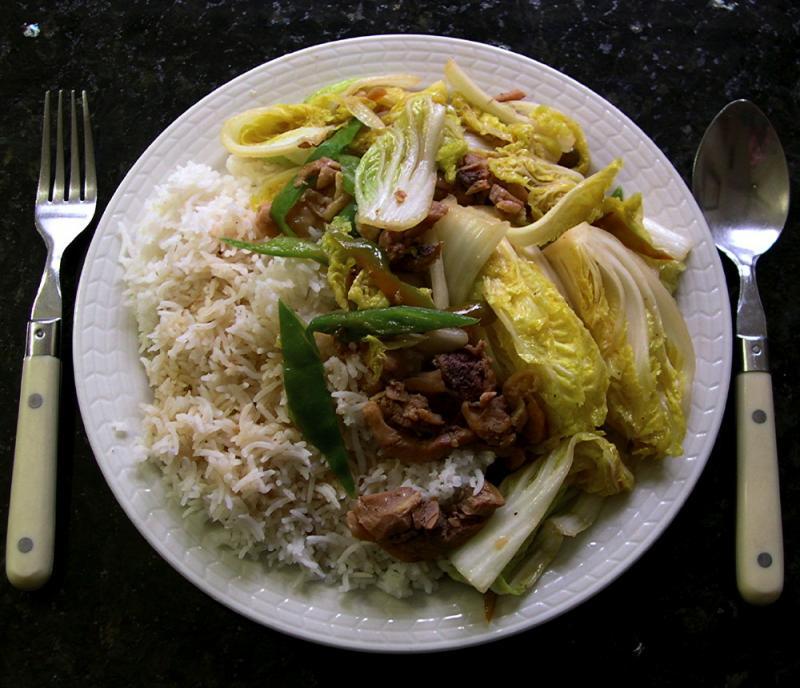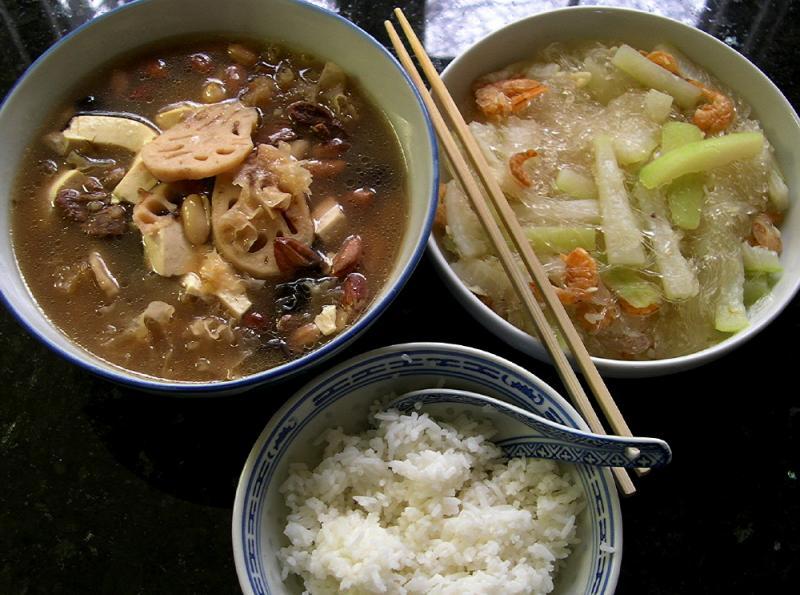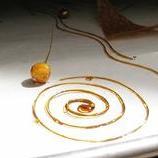Search the Community
Showing results for '"raw peanuts"'.
-
Early dinner. • Lotus root soup. Short-cut pork spare ribs sautéed with garlic, salt, water, "Yook Chook" (玉竹; Yale: yuk6 juk1; Polygonatum odoratum (Mill.) Druce), "Chan Pei" (陳皮; Yale: chan4 pei4; dried tangerine peel), dried longan flesh, dried Chinese jujubes (two varieties - lam jou plus ones from Shandong), dried cuttlefish (two small + one medium sized ones), sliced lotus root, raw peanuts. • Garlicky chicken. Chicken leg quarters, cut up; sautéed w/ two-heads'-worth of garlic cloves (lightly crushed) and halved shallots; w/ corn oil. Water added plus splashes of rice vinegar, hon-mirin + jozo mirin; seasoning adjusted, simmered down. Eaten w/ Fuzhou-type fine wheat noodles (min6 sin3, a.k.a. mee sua; I used this one (Taiwanese brand)). • Stir-fried large mustard green ("kai choy"; 芥菜).
-
Asia Mart: Fried tofu puffs, garlic, limes (69¢ EACH! Damn lime shortage), melon cake (老婆餅; "wife cake", "sweetheart cake"), firm tofu, Little Cook mushroom vegetarian noodle (bowls) and Spicy Beef noodle (bowls), Sapporo Ichiban chicken flavor noodle (packs), dried jujubes (from Shanxi), dried jujubes (from Shandong), honey jujubes, raw peanuts, dried hot red chillies, fresh Thai chillies, frozen pandan leaves, corn oil, fresh vegetables [Chinese long beans, bitter melons, coriander leaves, scallions, Japanese onion (negi), lettuce stems, Taiwan bok choy, large mustard greens(芥菜)], fresh lotus roots, fresh ginger, fresh turmeric, whole beef shins/shanks, pork spare ribs (short-cut), frozen stewing chicken. Pic of (L to R) samples of: lettuce stems, Taiwan bok choy, large mustard green. The mustard green is the type used to make pickled mustard used in Harm Choy Tong.
-
Pork belly & lotus root soup. Lotus root segments, scrubbed; sliced pork belly; smashed garlic. Pork belly slices beimng sautéed w/ the garlic in peanut oil. Some other stuff that went into the developing soup. Starting from 11 o'clok and going clockwise: Large Chinese jujubes, honey jujubes (Chinese red jujubes preserved by drying and soaking in honey), dried (& lightly salted) cuttlefish (three of them), dried Goji berries, raw peanuts. Soup being cooked. Salting/seasoning adjusted. Bowl of the finished soup.
-
Today: Indy Winter Farmers' Market & City Market: Teeny carrots (first of the year), baby spinach (red-stemmed & normal); 'Toscana' cheese; Spanokopita. Goose the Market: Local shrimp (Pacific white shrimp; from a shrimp farm in Crawfordsville); Taleggio cheese (Ciresa), Salemville Blue cheese, Jamon Serrano (two think-ish slices; as substitutes for Jinhua ham for some soups to be made later), a nice baguette. From a local grocery: Fresh limeade, collard greens, green cabbage. From 2 days ago: Asia Mart: Instant Noodle King (Thin) Wonton Soup Flavored (1 case) [sau Tao], Instant Noodle King (Thin) Lobster Soup Flavored (1 case) [sau Tao]; rice flour, glutinous rice flour, wonton wrapper (thin) Shanghai-style, fish meat emulsion (paste) [Venus], vegetarian spring rolls, a bottle/jar of baechu kimchi, soft tofu & firm tofu [Hinoichi], yellow tofu [Phoenix], Ti Guan Yin oolong tea, red Szechuan peppercorns, green Szechuan peppercorns, raw peanuts; daikon, burdock root, green onion/scallion (6 bunches), coriander leaves (3 bunches), Japanese cucumbers, jicama, fresh Chinese far koo mushrooms, Chinese yellow chives, water spinach (ong choy), lotus roots, Yu Choy Sum, Chinese celery, (all vegetables fresh); frozen (and thawed) shrimp; pork belly slices, whole beef shins, ground pork, big mouth bass (fished from the tank and bopped on the head and gutted there); jozo mirin [Morita], Thai Hom Mali rice [Golden Elephant].
-
Some soups from the last two months. • Pork meatballs & daikon in peppery pork stock. • Kale in chicken broth. (scroll down) • Fuzzy melon (a.k.a. Hairy gourd) soup; w/ short-cut pork spare ribs, garlic, cellophane noodles. (scroll down) • Harm Choy Tong w/ chicken legs. (scroll down) • Another version of Harm Choy Tong. • Fish tofu soup w/ garland chrysanthemum, Napa cabbage, white mushrooms, garlic; in chicken stock. (scroll down) • Choy Kon Tong (dehydrated Cole soup). (scroll down) • Soup of pork spare ribs, fresh Chinese mushrooms, snow fungus, daikon, garlic, chicken stock. (scroll down) • Bak Kut Teh (Herbal Hoklo-Canto variety) w/ fried tofu puffs. (scroll down) • Bak Kut Teh w/ pork hocks & pork spare ribs. Heavy herbal treatment & heavy saucing. • Beef shin stew w/ root vegetables. • Angled loofah soup w/ pork spare ribs & snow fungus. • Rice congee cooked w/ pork spare ribs & a form of preserved mustard. (scroll down) • Rice congee w/ sliced pork belly & ja3 choi3. • Slow-simmered chicken broth w/vegetables. (scroll down) Another iteration here; and also here (scroll down). • Cabbage, parsley & garlic soup; chicken stock. (scroll down) • Lotus root soup; w/ chicken & beef, garlic, oil, raw peanuts, lam jou, goji berries, yook chook (Solomon’s Seal rhizome), dried salted oysters, water, salt. • Lotus root soup. With pork short-cut spare ribs, garlic, Chinese jujubes, honey jujubes, goji berries, raw peanuts, dried cuttlefish, sea salt. • A riff on Tachiyama Chanko-Nabe. (scroll down) See also here. • Chanko-Nabe Miso-Aji. Noodle soups, many from dressing up “instant noodle” packs or building upon them: • Pork & cabbage dumplings, poached eggs, skinny wonton noodles in chicken stock, leaf celery, chopped scallions. (scroll down) • “Ho Fan Abalone Chicken Soup Flavored” with sliced Chinese BBQ pork, seafood & cabbage dumplings, and edible chrysanthemum. (scroll down) • “Sau Tao Noodle King Wonton Flavor noodles” w/ lots of chopped scallions & poached eggs. • “Instant Noodles Artificial Hot & Sour Shrimp Flavor” w/ leafy celery leaves & stems, Dodge City salami & Prosciutto Rosa. • “Pickled Cabbage Flavor Instant Vermicelli” w/ leafy celery, pressed tongue & hard-boiled eggs. • Baechu kimchi, bamboo shoots, fried tofu puffs, scallions & garlic soup; with the ho fun plus the soup sachet from a “Ho Fan Abalone Chicken Soup Flavored” package. • “Spicy Kimchi Flavor Bowl Noodle Soup”, w/ white standard mushrooms & trimmed scallions. • “Instant Noodles Artificial Seafood Flavor”, w/ Napa cabbage, poached egg, fish tofu & scallions. • “Myojo Chukazanmai Oriental Flavor ramen” w/ young Tuscan kale, quartered white mushrooms & Chinese roast duck. • “Ibumie Penang Har Mee instant noodle” soup; w/ water spinach, fried tofu puffs & hard-boiled eggs. • “Sour-Hot Flavor Vermicelli”, w/ sliced Debreziner sausage, a few splashes of Chinkiang vinegar, chopped Napa cabbage & scallions. (scroll down) • Beef, veal & celery meatballs; in beef & sautéed garlic stock, w/ chopped curly kale & banh pho noodles. (scroll down) • “Sapporo Ichiban Chicken Flavor Ramen”, w/ standard celery, leafy celery, Chinese roast pork, eggs poached in situ. • Daikon-porkballs-white pepper soup, w/ min6 sin3 (mee sua). • Pork & shrimp wontons & skinny wonton noodles soup, w/ choy sum. Edited to fix formatting.
-
Couple of lunches. ----------------------------- • Sliced pork belly marinated w/ Shaohsing wine, black pepper, sesame oil, ryori-shu, mirin, oyster sauce; stir-fried w/ Western celery, scallions, baby leeks. • Lotus root soup. Made w/ chicken & beef pieces, smashed garlic, vegetable oil, raw peanuts, lam jou (a sort-of smoked large Chinese jujubes), kei chee (Goji berries), yook chook (dried rhizome of Polygonatum odoratum), dried salted oysters (of a variety called 沙井蠔豉) (from the Pearl River delta), water, salt. • White rice (Basmati). ----------------------------- • Smashed garlic (lots) sautéed w/ bamboo shoots, chopped baechu kimchi, sliced scallions & coriander leaves. Eaten w/ skinny wonton noodles. • More of the lotus root soup from the previous lunch.
-
Several lunches from recent days. -------------------------- • Pan-fried King Oyster mushroom slices; w/ just salt & pepper. • Lotus root soup. With pork short-cut spare ribs, garlic, Chinese jujubes (lam jou variety), Honey jujubes, Goji berries (kei chee), raw peanuts, dried cuttlefish, sea salt. ------------------------- • Bak Kut Teh (Herbal Hoklo-Canto variety) w/ fried tofu puffs. • Gai Lan, stir-fried w/ garlic & a sauce mixture of aged Kimlan soy sauce, Morita ryori-shu, Kimlan luscious soy sauce, sesame oil [Dragonfly], oyster sauce [LKK], white pepper. • Yau Char Kwai (youtiao; Chinese crullers). • White rice (Basmati), cooked w/ fresh deep-fried shallots and shallot oil, garnished w/ fried shallots. -------------------------- • Fresh broad linguine [Nicole-Taylor’s]; tossed w/ a sauce of unsalted butter, chopped walnuts, gorgonzola dolci (melted in), heavy/whipping cream. Dressed w/ parsley florets. Had seconds and thirds; ate the whole pan of it, carb coma ensued. Zzzzz. -------------------------- • Leftover seared/roast picanha, sliced. • Boiled fresh fingerlings. • Leftover salad (Spinach, Napa cabbage, Shunkyo radish, oil & vinegar, salt, pepper) -------------------------- • Fresh pork sausage (schnecken; [Claus’]) pan-fried then sautéed with the remainder of the bamboo shoots mixture from dinner the previous day, plus a bit more Szechuan-type “nga choy” (suimiyacai). • Black rice noodles (黑米面/黑米麵) [Havista] [actual Chinese brand: 五穀豐牌]. • More “Choy Kon Tong”, cooked the previous day and left at RT (covered pot), now deeper in flavor.
-
I just got bag of raw peanuts. They are already shelled. However, can I still make boiled peanuts? How long do I boil them for? All recipes I've used before for peanuts in the shell. Soup
-
2013-0424 Lunch • More of the beef short ribs, daikon & “Far Koo” soup, well-developed/matured in taste now; with a bundle of “Fun See” (粉絲; cellophane noodles) added in to the reheated portion of the soup taken. 2013-0425 Lunch • A riff on lotus root soup. Generous garlic (~ 1 head, deskinned, dehearted, halved) sautéed in veggie oil; baby pork back ribs (1/2 rack, cut into riblets) added, sautéed w/ sea salt; water added, brought to a simmer; added in “Tai Nam Chou” (大南棗) (large sort-of-smoked large Chinese jujubes), generous “Yook Chook” (玉竹; Yale: yuk6 juk1; Polygonatum odoratum (Mill.) Druce), raw peanuts, finely sliced soaked wood fungus (木耳), a couple of dried cuttlefish (小墨魚) (see here); and the mix simmered for about ½ to ¾ hour. Soaked, trimmed snow fungus (Tremella fuciformis) and thinly-sliced de-skinned long-type (i.e. crunchy-type) lotus root added and the mix simmered till done. Left overnight to meld further and reheated for lunch. Except for the hard pits of the jujubes and the pork rib bones everything is now edible; but the soup itself – the broth – is the more appreciated part. Yum. • Rat tail noodles (老鼠粉; Yale Cantonese: lou5 syu2 fan2)§ dressed w/ a chicken liver sauce¶ & chopped scallions. § In Hong Kong & Taiwan (& mainland China, I believe) it would be better known as “Silver Needle Noodles”, 銀針粉; Yale Cantonese: ngan4 jam1 fan2. See the wiki article. ¶Generous sliced shallots & a couple of chopped smashed garlic cloves were sautéed in veggie oil; chopped fresh chicken livers added & the mix stirred a bit; followed by fish sauce [Red Boat], Ryori-shu [MRT], sweet mirin [Honteri], light soy sauce (“Sang Chau”; 生抽) [Kimlan; Grade A], a splash of rice vinegar [Marukan] plus a little water and the mixture stirred then covered and simmered for a while. Some sesame oil [Dragonfly] was added towards the end.
-
• Lotus root & pork spare ribs soup.§ With garlic, jujubes, raw peanuts & fresh "Far Koo". • Bone-in chicken¶ stir-fried/sautéed with garlic, Napa heart & hot green chillies. • White rice (Basmati). § Short-cut pork spare ribs sautéed w/ lightly crushed garlic cloves plus some salt till fond is well developed then water added. Simmered for 10-15 minutes or so, sliced lotus root & jujubes‡ added, followed shortly by the fresh "Far Koo" mushrooms (flower-patterned thick cap shiitakes; quartered) and peanuts and the mix simmered till done, about 1+ hour or so. ¶ Chopped-up chicken pieces pre-marinated w/ Shaohsing wine (Wei Chuan), fish sauce (Red Boat), fresh ground black pepper, sesame oil (Dragonfly). The smashed, chopped garlic was tossed in the hot pan containing oil, the chicken + marinade tossed in quickly, the mix stirred/banged around; followed by the sliced hot long green (ripening to orange) chillies and trimmed leaves of the heart of a Napa cabbage ("Wong Nga Pak") almost at the end - the idea was to just barely cook the Napa cabbage and retain the crispiness/crunch of it as far as possible. ‡ I used "大南棗" today, a.k.a. "Blue Dates". They're not actually blue in color but are very dark black-red visually, are larger than the more common "red dates" and have a smoky smell to them. Side note: The currently accepted name for Chinese dates/jujubes appears to be Ziziphus jujuba, rather than the Ziziphus zizyphus previously used which is recognized as a synonym. See: http://www.theplantlist.org/tpl/record/kew-2470699
-
Here's one from the Eleven Madison Park Cookbook (with some modifications): Crimini mushrooms three ways (poached in olive oil-white wine reduction on pan-fried bread rounds, pickled, and raw), peanut puree, fresh garden greens, crushed peanuts, and peanut vinaigrette. I've never been a huge fan of Crimini mushrooms, but the poached ones are delicious.
-
I was in the mood for more "Tai Yee Ma Kar Lui" [大姨媽嫁女] today. (Hairy gourd with cellophane noodles & dried shrimp) Made a lotus root soup to go with it. (Beef slices sautéed w/ garlic, water, sliced lotus root, snow fungus, fresh cloud ear fungus, raw peanuts, soft tofu, sea salt) White rice. (Hom Mali)
-
So I bought a couple of pounds of raw peanuts in their shell - it's the season, adn they're all over Chinatown. In the past, I've done some Szechuan boiled peanuts, after removing them from their shells. They cooked for about 1.5 hours. Recipes I've read today for "southern" boiled peanuts call for boiling them in their shells for 4 to 5 hours. And then I read a recipe or two for roasting that calls for roasting them for 35 - 45 minutes and they're done...no way. These peanuts have been in the oven for 1.5 hours and are barely done. So, what's the deal...how do you roast your peanuts and... what do you do with them once they're roasted? Other than just eat them out of the shell, by the way.
-

Life is too short to do it the right way...
sparrowgrass replied to a topic in Food Traditions & Culture
I use dry roasted peanuts (Planters low salt) in my most excellent peanut brittle. The recipe came from my Aunt Rosie, and it called for raw peanuts, put in after the sugar dissolved and cooked in the hot syrup and stirred constantly. Too much work. Cook the syrup to 305, dump the peanuts in and stir just enough to incorporate. Then add the baking soda. If you warm the peanuts in the microwave a bit, the syrup stays liquid enough to stir the soda in after a brief heatup. -
The word 肉 in this title name refers to the nuts inside peanuts (versus the skin/shells). It's interesting that I did some google search about 南乳肉花生 They said the recipe is to soak the raw peanuts in liquid/water mixed with red beancurds overnight. Then air-dry the peanuts. Then stir-fry the peanuts with some "yellow sand" (not sure what that is... probably some coarse sand/pebbles). I am not sure how they separate the yellow sand from the peanut though. May be a sift?
-
Tonight, I made Turkish Delight from Peter Greweling's excellent Chocolates and Confections at Home. The recipe was reasonably straight-forward, until I got toward the end. The recipe calls for whisking the sugar syrup and starch paste over low heat until smooth and clear, and says this will take around 20-25 minutes. I didn't have a problem with the mixture coming together. It was pretty smooth the entire time, and I was just waiting for it to go clear. What I was looking for was for the opaque, frosty mixture to hit a point where it would turn clear so that I could see the bottom of my whisk, but this did not happen, even after standing there stirring for almost 40 minutes. I then quickly had a look at the Turkish Delight recipe in Greweling's professional book, and even though the ingredients were different, I took note that that recipe calls for cooking to 223F. I checked the temperature of my mixture, and it was only around 205F. Out of impatience, I added the mix-ins and poured the mixture into my prepared pan. I will see how it turns out tomorrow, but I would love to know: 1) Did I take the mixture off too soon? If I had persevered, would it have magically become clear after reaching a certain point, or is Greweling's description of "smooth and clear" as an indicator of when it's done somewhat vague and/or misleading? 2) I presume that whether I under- or overcooked the mixture, this would affect the texture of the final product? Or is it the initial cooking of the sugar syrup to 260F the primary determinant of the final texture? 3) The recipe calls for 12oz shelled, unsalted, and undyed pistachios. Should they be raw or toasted? I used raw. I've made Greweling's Peanut Brittle, which calls for adding raw peanuts to a sugar syrup at a much higher temp, which obviously cooks the peanuts. But would adding raw pistachios after taking the mixture off the heat be sufficient to "toast" the pistachios? In addition, I used 200g of pistachios, and I think even that quantity is too much for the amount of Turkish Delight produced. I would use only 100g next time, unless you're going for quite a pistachio-dense Turkish Delight. Thanks for any guidance, and I will report back tomorrow to share how the Turkish Delight turns out. Cheers!
-
I got into New Orleans a little bit, so I would include real andouille and tasso, raw peanuts freshly fried, Acme grilled oysters and soft-shell shrimp (at Coquette) for new to me taste sensations. Black garlic was an ingredient that I only became aware of in 2009, though I first had it in 2008. Believe it or not, I had never actually eaten goose before 2009, though I had eaten goose products such as foie gras, goose fat and goose eggs.
-
The first iteration is cooling now: 12 oz. raw peanuts 2 T. peanut oil 1/4 c. brown sugar 2 T. lime juice 1 tsp. sriracha 1/4 tsp. cayenne 1 tsp. kosher salt, plus more to finish I pan-roasted the nuts a bit, removing the loose peanut skins, then took them out of the pan and made a syrup with the other items. The nuts then returned and were stirred until the glaze was attached to them. Nuts were spread out to cool and a little more salt added. Initial impressions: nice amount of heat and salt; the peanuts with the skins on are a lovely glossy dark brown and have more flavor than the bare ones. Both the lime and the sugar are NOT noticeable. I don't mind the lack of sweetness but do want a little tang. I have lime OIL, but that would not be sour; also more limes if zest would be a good idea. Hmmmmmmm?
-
I stocked up on raw peanuts and limes today; also remembered that I have palm sugar here. As far as the bitter goes, is the lime sufficient to cover that as well as the sour note?
-
I just looked at your recipe. It looks fairly standard in terms of ratios, except that it is missing water as an ingredient. And, I always start with raw peanuts and add them after the temp gets to 250°, that way they cook in the sugar and impart more flavor. (and there' no chance of them being rancid) I'd start with a cup of water in the pan, and have a squirt bottle or brush and water available to wash down the sides as it cooks. A straight melt, like the recipe offers, is a lot more difficult to control than a melt with water. Try looking around at regular peanut brittle recipes and you'll see that the water is pretty standard. (and the washdown is always necessary) It's even in the peanut brittle in the CIA's newest pastry text. The lack of water may have been your problem all along. As for the bacon, I am thinking that what you might wish to do is, place the bacon in the pan you're going to pour into, and just pour the sugar/nut mix over it. That way, the fat isn't part of the boiled sugar at all. One more tip. Try scattering kosher salt over the top of the brittle as if it were a giant pretzel. This is optional but tasty.
-
Where are you folks finding raw peanuts? I have been looking around forever, because I want to make boiled peanuts, and roast my own, etc, and every time I think I've found them, they're always ALWAYS roasted. Is it a regional thing, or am I looking for nuts in all the wrong places?
-
Oh, no doubt that would be far easier! I simply had access to very, very fresh raw peanuts when they first came into season around here. The first batch I made was far and away the best-tasting peanut butter I had ever had. But it was a huge pain in the butt, and probably not worth the effort even to a hard-core peanut-butter eater like me. I'd like to try it again, but I want to figure out what the tricks are first.
-
Recently I've made a couple of batches of Mafé. Since it was peanut season at the time, I bought some fresh raw peanuts at the produce market and started there, but it turns out I don't really have the first idea how to do it. What I wanted to do was start by making what was in essence a home made peanut butter. That meant I needed to roast, shell, and grind the nuts. So, first off: do you roast them in the shell or out? What temp, for how long? How do you know when they are done? Second, when making peanut butter, do you remove the inner (red) skin from the "nuts" or leave it on. Is there a trick for removing it? Something that doesn't involve doing each little legume by hand? Finally, I was hoping I could just whiz them in the food processor until they formed a paste. The first time this worked fine, but on my second attempt they simply would not paste-ify. What's the trick?
-
Am I correct in assuming that it would be a mistake to use caramelized cacao nibs in a brittle because they are already cooked and would therefore burn in the process? Greweling's Peanut Brittle calls for raw peanuts, with a variation of 'cocoa nibs' with no mention of raw, cooked or otherwise. Thanks edited for typos
-
Jaz - I've been making caramel corn for 30 years, having learned at the elbow of my grandfather - 'nuff of that. Instead of using roasted, salted nuts at the end of your cooking process, try adding the same volume of raw peanuts 1/2 through your cooking time. They'll still "sink" but they will all become mixed with the corn once you complete your cooking process, add the corn and stir


